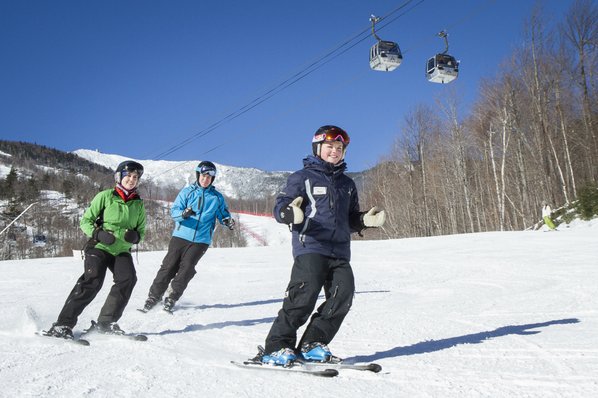
Credit: AP/ORDA/Whiteface Lake Placid
This Jan. 14, 2015 photo provided by ORDA/Whiteface Lake Placid, shows Megan Gardner, right, as she teaches participants in a lesson at Whiteface Mountain in Wilmington, N.Y., near Lake Placid.
By JOHN KEKIS THE ASSOCIATED PRESS
Posted: January 15, 2017 at 1:48 a.m.
WILMINGTON, N.Y. — When Aaron Kellett peers out the window of his office at Whiteface Mountain, these days he’s usually smiling.
“My office is right next to our beginner trail, and when I look out I see people on our beginner trail,” said the 38-year-old Kellett, who’s been the manager at Whiteface for four years. “That means we’ve got new people learning how to participate in our sport.”
And that’s a good thing. As baby boomers begin to pull back from the athletic activities of their youth, ski resorts are focusing on attracting new participants to the slopes. The idea is to get them there and keep them, and the millennial generation — those between the ages of 18 and 34 in 2015 — tops the target list.
According to the latest demographics from the Colorado-based National Ski Areas Association, baby boomers — aged 52 to 70 in 2016 — and those 71 and older have steadily become a smaller share of the visitor base as they’ve aged. Combined, in the past decade they’ve declined from 36.2 percent of visitors to 21.3 percent.
Millennials, on the other hand, represent the largest group of snowboarders and skiers, but they also have the fewest number of days per season. The figures show that the industry will need to increase the frequency of the millennial participant to match that of the exiting baby boomer.
“That’s a significant wake-up call for us. There’s some challenges there,” said Nate Fristoe, director of operations at RRC Associates, which last year produced a report on the millennial generation. “We have this funny little dilemma. We’re trying to build participation. We know we have to grow participants, but we also know that on most of our weekend days we’re hitting capacity.
“It’s a fascinating conundrum,” Fristoe said. “Yes, we have a product offering that has appealed to an older generation for years. It also appeals to this generation in many ways, but there are ways in which we need to tweak it.”
To be sure, millennials are different. They embrace the environment, like to plan spontaneously, prefer to travel with friends and crave healthy food. They also relish sharing their adventures on social media.
“Millennials are harder to attract, for sure. It’s not as cut and dried as it was even 10 years ago,” Kellett said. “They want the best deals and they’ll do whatever it takes to get the best deal. They don’t mind spending money to do what they want. It’s the experience. It’s so much more than just skiing.”
Kellet says online ticket sales have been “huge” for Whiteface because of the savings they offer.
Whiteface, which has plenty of post-ski entertainment in nearby Lake Placid, offers a Parallel from the Start program for beginners. It costs $169 and includes everything needed to start skiing, except the clothing — lesson, equipment rental, and three days of skiing. “It’s an awesome way to be introduced to the sport. It works,” Kellett said.
In neighboring Vermont, the cost is $129 for a Take 3 pass — three ski or snowboard lessons that include rental equipment for the day and access to beginner terrain. The Green Mountain State also offers a $49 beginners package during January, national Learn to Ski and Snowboard Month nationwide.
“Cost can be a hurdle, so anytime we can lower that hurdle a little bit, especially for beginners, we see more people participate for a longer period of time,” said Sarah Wojcik, marketing director for Ski Vermont. “Getting new people to the slopes with incentives and then keeping them are two of the biggest goals nationwide.”
The granddaddy deal of them all might be the Epic Pass offered by Vail Resorts. It’s the most popular pass in the ski industry and features unlimited, unrestricted skiing at all of the company’s mountain resorts. It also will include Whistler Blackcomb next winter season (2017-18), and offers five days at 30 resorts in Europe.
With the rise of social media and mobile phones, most ski resorts are trying to provide easy-to-navigate websites and free Wi-Fi so visitors can share their experiences digitally — think Snapchat. Excellent cellphone service is a must.
“Your website being mobile-friendly is kind of millennial-speak 101,” Wojcik said. “If you can’t look it up on your phone, it’s really difficult to get the message out there.”
At Taos Ski Valley in New Mexico, which was cited by the Ski Areas Association for having the best overall marketing campaign for 2016, millennials aren’t separately targeted but the demographic is important.
“Millennials are big on experience, and Taos Ski Valley has long been known for delivering an authentic, unpretentious and culture-rich winter mountain experience,” marketing manager Dash Hegeman said. “That is something we work very hard to protect and cultivate.”
SundayMonday Business on 01/15/2017
https://www.nwaonline.com/news/2017/jan/15/ski-resorts-woo-millennials-to-replace-/?business-national



